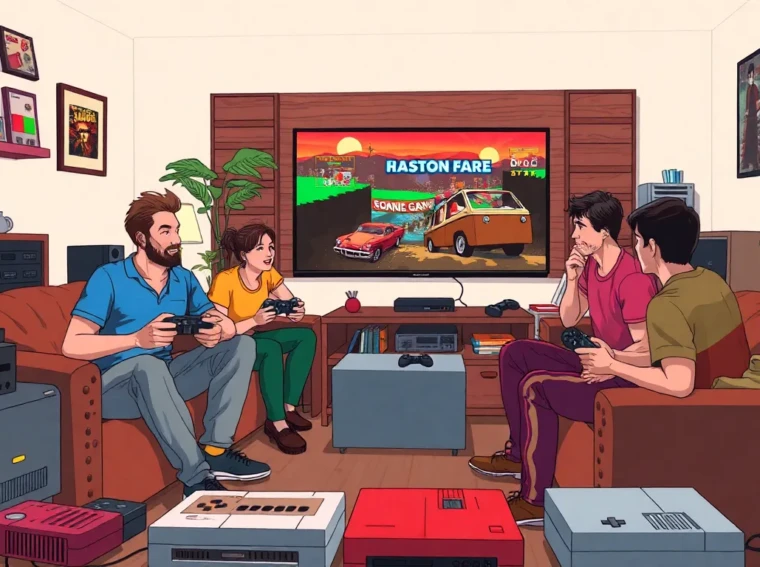Video game consoles have come a long way since the days of pixelated Pong. From the chunky cartridges of the 80s to the sleek, powerful machines of today, each generation has brought something new to the table—whether it’s jaw-dropping graphics or the ability to stream games while wearing pajamas. Who wouldn’t want that?
As gamers, they can’t help but marvel at how these consoles have evolved, each new generation reshaping the landscape of entertainment. With every leap forward, there’s a mix of nostalgia and excitement, as they remember the good old days of blowing into cartridges while eagerly anticipating what the next big thing will be. Buckle up as we dive into the fascinating world of video game console generations, exploring how they’ve transformed the way we play and connect.
Video Game Console Generations
Video game consoles have evolved significantly since their inception. The first generation, comprising systems like the Magnavox Odyssey, introduced gamers to simple, rudimentary titles. Following this, the second generation featured cartridges which allowed for more complex gameplay, marking a notable shift in the gaming landscape.
The third generation centerpieces included notable brands such as Nintendo and Sega, with the Nintendo Entertainment System leading the charge. Players enjoyed iconic games like Super Mario Bros, revolutionizing platform gaming. Growth continued into the fourth generation, with 16-bit graphics and titles like Sonic the Hedgehog, enhancing visual experiences and gameplay mechanics.
Entering the fifth generation marked a leap into 3D graphics and CD-ROM technology. Notable consoles such as the Sony PlayStation and Nintendo 64 changed how games were experienced. Innovations from this period emphasized richer storytelling and immersive worlds, delighting players globally.
The sixth generation transitioned further with online gaming capabilities. Consoles like the Xbox, PlayStation 2, and Sega Dreamcast established a new realm of multiplayer interactions, allowing players to connect in real-time. This generation saw a significant shift in how social interaction was integrated into gaming.
In the seventh generation, HD graphics and digital distribution became standards. Consoles such as the Xbox 360, PlayStation 3, and Nintendo Wii focused on accessibility while broadening the gaming audience through innovative motion controls and online services.
Today, the eighth generation continues to push boundaries, incorporating virtual reality and cloud gaming. Systems like the PlayStation 5 and Xbox Series X exemplify advancements in processing power and graphics quality, providing unparalleled gaming experiences. Each generation builds on its predecessor, fundamentally shaping how players engage with games and each other.
First Generation Consoles

First-generation consoles marked the beginning of home gaming, introducing basic systems and simple gameplay mechanics. These consoles laid the foundation for the video game industry as we know it today.
Key Features
First-generation consoles featured simple hardware with limited processing power. Most operated on analog technology, providing basic visual outputs. Players often experienced built-in games or switchable modules with a handful of options. Iconic systems, like the Magnavox Odyssey, didn’t use cartridges and relied on overlays for graphics. Simple controllers with few buttons allowed easy navigation through gameplay. Key features highlighted the novelty of gaming at home, capturing the attention of early adopters.
Notable Titles
Notable titles from this generation included classics such as Pong and Tennis. Pong, released in 1972, became the first commercially successful video game, sparking widespread interest. Tennis, another popular title, simulated ping-pong matches and showcased the industry’s potential. Players enjoyed these games in a competitive manner, enhancing the social experience of gaming. The simplicity of these titles, combined with their competitive nature, laid essential groundwork for future developments in game design and play styles.
Second Generation Consoles
Second generation consoles marked a significant evolution in gaming technology with the introduction of cartridges, enabling a broader range of games. This era saw enhanced graphics and more complex gameplay compared to its predecessor.
Key Features
Cartridge-based systems defined this generation, allowing easier game swapping and storage. Improved graphics capabilities introduced more colorful visuals and sophisticated audio. Notably, the development of programmable chips enhanced gameplay variety. Dual players became more common, enriching cooperative gaming experiences. Additionally, the growing popularity of home consoles led to increased competition among manufacturers.
Notable Titles
Some iconic titles emerged during this generation. “Pong” captivated audiences, while “Space Invaders” popularized the shooting genre. “Pac-Man” created a cultural phenomenon, across various demographics. “Atari 2600” delivered a wide selection of games, including adventure and action titles. Other noteworthy games included “Pitfall!” and “Adventure,” expanding gameplay diversity. These titles laid the foundation for future genres, significantly shaping the gaming landscape.
Third Generation Consoles
Third generation consoles marked a pivotal evolution in gaming, characterized by significant advancements in technology and game design. The introduction of 8-bit processors transformed how developers created games, enhancing both graphics and sound.
Key Features
8-bit processors defined this generation, allowing improved graphics and sound capabilities over previous iterations. Increased game complexity emerged from support for more colors and detailed sprites. Multi-platform development became common, enabling games to reach a broader audience across various systems. Memory management improved, leading to larger, more expansive games with intricate designs and mechanics. The introduction of battery-backed save features also emerged, allowing players to save progress, an essential aspect for longer gameplay.
Notable Titles
“Super Mario Bros” redefined platform gaming with its innovative level design and memorable characters. “The Legend of Zelda” introduced an open world experience, emphasizing exploration and puzzle-solving elements. “Metroid” fused action and adventure, showcasing intricate environments and immersive storytelling. Meanwhile, “Mega Man” presented unique gameplay mechanics through its robotic protagonist, appealing to a wide range of players. The diversity in titles during this generation laid the groundwork for future gaming genres, illustrating the creative potential of console gaming.
Transitioning Between Generations
Transitioning between console generations introduces both challenges and opportunities for gamers and developers. Market shifts require adaptation from players familiar with previous systems to newer technology, impacting gameplay experiences. Console manufacturers often implement backward compatibility, allowing users to play titles from earlier generations on new machines.
Sales figures highlight this trend; for instance, the Xbox Series X and PlayStation 5 launched with strong backward compatibility features, allowing players access to vast game libraries. Developers frequently remaster popular titles to better utilize the latest hardware capabilities, providing improved graphics and gameplay enhancements.
Cultural shifts also occur during transitions, as gaming communities react to evolving technologies and gameplay mechanics. As the gaming landscape changes, users often express nostalgia for past console generations while exploring fresh experiences offered by advanced systems.
Hardware upgrades typically showcase enhanced graphics, processing speeds, and storage solutions, making games more immersive. Players notice improved load times and increased frame rates, which significantly enhance gameplay enjoyment. Additionally, the integration of digital distribution, particularly during the seventh generation, transformed how players acquire and engage with games.
As developers embrace online features during each transition, gaming becomes more connected. Social interactions evolve, with communities forming around multiplayer experiences and competitive gaming. By recognizing trends across generations, stakeholders can better anticipate the future of gaming technology and cultural engagement.
Communicating these advancements effectively helps keep gamers informed and excited about what lies ahead. The continuous evolution of consoles not only reshapes player interactions but also fortifies the bond within the gaming community.
Current and Future Generations
The eighth generation of consoles, including the PlayStation 5 and Xbox Series X, showcases remarkable advancements in gaming technology. This generation emphasizes features like virtual reality and cloud gaming, reshaping player experiences. Backward compatibility plays a crucial role, enabling users to access extensive libraries from previous generations effortlessly.
Transitioning to new technologies often presents challenges. Adapting to updated systems can alter gameplay experiences, with players adjusting to different interfaces and mechanics. Notably, remastering popular titles enhances graphics and brings beloved games to modern consoles, ensuring lasting engagement.
Cultural reflections emerge as communities navigate these advancements. Nostalgia for past consoles coexists with excitement for today’s innovations, uniting players across generations. Hardware upgrades contribute significantly to enhanced graphics, faster processing speeds, and expanded storage solutions. Engaging in online platforms fosters connections between gamers, creating vibrant communities.
Trends in gaming technology hint at future developments. Anticipated advancements could focus on further integration of online features and improved immersive experiences. Industry stakeholders can leverage these insights to understand market demands and cater to evolving player interests. The continuous evolution of consoles reinforces relationships within the gaming community, enhancing the overall gameplay experience.
Innovation and Nostalgia
The journey through video game console generations reveals a rich tapestry of innovation and nostalgia. Each generation has built upon the last, transforming gaming into a dynamic and immersive experience. As technology continues to evolve, the gaming community eagerly anticipates what the future holds.
With advancements like virtual reality and cloud gaming on the horizon, the possibilities seem limitless. Gamers can look forward to not only enhanced graphics and gameplay but also deeper connections within their communities. The legacy of past consoles continues to influence today’s innovations, ensuring that the passion for gaming remains strong across generations.

